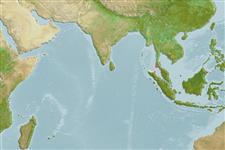Environment: milieu / climate zone / depth range / distribution range
Ecology
Marine; reef-associated; depth range 3 - 20 m (Ref. 89707), usually 3 - 13 m (Ref. 41648). Tropical; 8°N - 0°N, 94°E - 99°E (Ref. 89707)
Eastern Indian Ocean.
Size / Weight / Age
Maturity: Lm ? range ? - ? cm
Max length : 18.8 cm SL male/unsexed; (Ref. 41648)
Dorsal
spines
(total): 9;
Dorsal
soft rays
(total): 15-16;
Anal
spines: 3;
Anal
soft rays: 8. Characterized by brown color with six distinct dark bars; head, body and fins with numerous small, black-edged blue spots; body scales ctenoid, including abdomen; greatest depth of body 2.7-3.0 in SL; rounded caudal fin; pelvic fins, 2.0-2.3 in head length (Ref. 90102); dorsal profile of head convex with slight indentation above posterior edge of orbit; snout length 4.0-4.3 in HL; orbit diameter 4.7-6.2 in HL; interorbital width 8.2-10.0 in HL; caudal peduncle depth 3.1-3.5 in HL (Ref. 089707).
Solitary, reef-associated (Ref 90102) found in mixed coral and rubble (Ref. 089707).
Life cycle and mating behavior
Maturity | Reproduction | Spawning | Eggs | Fecundity | Larvae
Randall, J.E. and U. Satapoomin, 2000. Cephalopholis polyspila, a new species of grouper (Perciformes: Serranidae:Epinephelinae) from southwestern Thailand and Sumatra. Phuket Mar. Biol. Cent. Res. Bull. 63:1-8. (Ref. 41648)
IUCN Red List Status (Ref. 130435)
Threat to humans
Harmless
Human uses
More information
Common namesSynonymsMetabolismPredatorsEcotoxicologyReproductionMaturitySpawningSpawning aggregationFecundityEggsEgg development
ReferencesAquacultureAquaculture profileStrainsGeneticsElectrophoresesHeritabilityDiseasesProcessingNutrientsMass conversion
Tools
Special reports
Download XML
Internet sources
Estimates based on models
Preferred temperature (Ref.
123201): 29.1 - 29.1, mean 29.1 °C (based on 3 cells).
Phylogenetic diversity index (Ref.
82804): PD
50 = 0.5000 [Uniqueness, from 0.5 = low to 2.0 = high].
Bayesian length-weight: a=0.01259 (0.00590 - 0.02687), b=3.04 (2.87 - 3.21), in cm total length, based on LWR estimates for this Genus-body shape (Ref.
93245).
Trophic level (Ref.
69278): 3.9 ±0.7 se; based on size and trophs of closest relatives
Resilience (Ref.
120179): High, minimum population doubling time less than 15 months (Preliminary K or Fecundity.).
Fishing Vulnerability (Ref.
59153): Low vulnerability (13 of 100).
